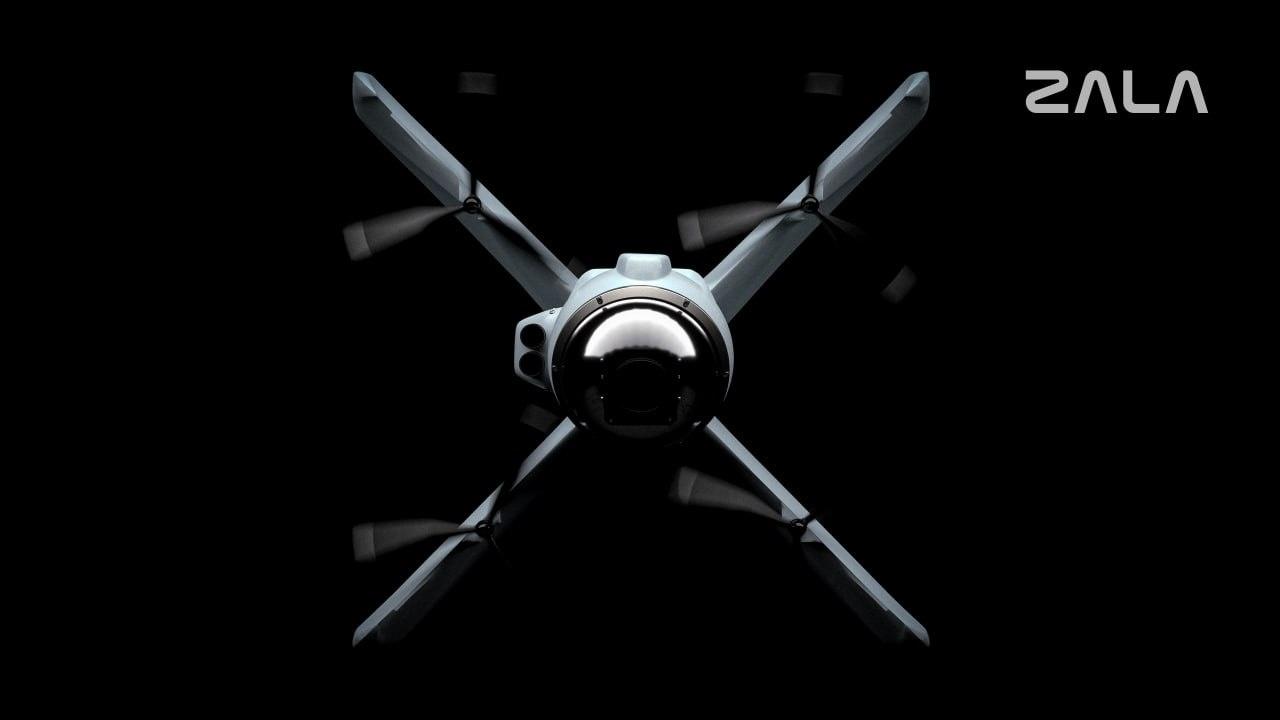The Lancet has been one of Russia’s most successful weapons in this conflict, a small loitering munition which has been deadly against Ukrainian tanks, artillery and even parked aircraft (in this case a decoy). Fortunately for Ukraine the number of Lancets has been low, but now the makers are introducing a new miniature attack drone known as “Item-55” (Izdeliye-55).
The makers, ZALA Aero Group, are 51% owned by the Kalashnikov Concern. The intention appears to be to create a weapon as cheap and effective as the parent company’s legendary AK-47 assault rifle.
ZALA announced Item-55 in a company Telegram post with one image but no specifications.
X-Wing Fighter
The new drone is clearly a quadcopter, but unusually it has X-wing aerodynamics similar to the previous Lancet. This arrangement has been seen in some previous small drones and even in some improvised FPVs deployed in Ukraine. The lift provided by the wings should give longer range than other small FPVs.
Unlike other small drones, Item-55 has remote container launch to keep the operator safe, like the U.S. Switchblade 300, except that the launch container can be positioned well away from the operator. As noted previously, some Russian groups are increasingly favoring remote launch to prevent operators being targeted.
The big selling point in the release is the new drone’s resistance to jamming: “The new technical solutions of the ZALA engineering and development team favorably distinguish the Izdeliye-55 from other loitering munitions, making it absolutely invulnerable to enemy electronic warfare systems.” (my emphasis)
No Jam Tomorrow?
Many see electronic warfare as the only way to effectively stop the growing onslaught of FPV drones. Ukrainian jammers clear have an effect, as seen by the profusion of Russian counter-jamming communications like this ‘magic radio’ from Hermes. Zala’s claim of absolute invulnerability puts them in a new class.
Any radio signal can be jammed, and any jamming can be countered; electronic warfare is a cat-and-mouse game in which jamming and communications endlessly leapfrog each other. This contest has been playing out in real time in Ukraine with the pendulum swinging from one way to the other. As electronic warfare expert Thomas Withington notes, there is no permanent answer.
So the jam-resistance may just be hype. Or it may indicate another approach.
“I suspect it’s an autonomy optimal mode,” Zak Kallenborn of CSIS’s Strategic Technology Program told Forbes. “The drone is able to navigate, and perhaps select and engage targets without human control. To be electronic-warfare- invulnerable in any meaningful way, the drone would need to have minimal to no reliance on external command to carry out attacks.”
ZALA may have built on one of the Lancet’s most notable features, onboard artificial intelligence able to classify and track targets, powered by a U.S.-made processor. This would put Russia on a level with Ukraine, which has already deployed smart drones capable of finding and attacking targets without operator input, though these are bombers rather than kamikazes.
The ZALA announcement does however mention the drone “Provides Full HD in real time until the moment of destruction” suggesting that they expect it to maintain a video link right up to impact.
Future Swarms
The Item-55 announcement does not mention swarming, a technology which ZALA is working on and showed off in a promotional video for their Product-53 Lancet upgrade. Swarming enables large numbers of drones to carry out coordinated attacks without human input.
“Multiple drones might hit the same target, or they might coordinate strikes on separate targets — ‘You hit that tank, I’ll hit this one,’” says Kallenborn.
He notes that this type of swarming would remove the invulnerability to jamming, because any communication between the drones would make the swarm susceptible to interference.
Market Competition
The Lancet costs something like $30k a shot, compared to around $400 for the type of FPVs produced by the thousand by Russian groups like Sudoplatov. New features like onboard intelligence and remote launch systems cost money, and Item-55 is likely to be considerably more expensive than the competition. That may not be a problem.
“I think the Russian Ministry of Defense will buy their stuff became its ZALA,” Samuel Bendett an expert on the Russian drone industry and adviser to both the CNA and CNAS, told Forbes.
Bendett notes that the success of Lancet has put ZALA on the arms sale map, and that the product launch may be as much about future international sales as meeting immediate needs.
“There will be a huge demand for loitering munitions on the arms market starting next year,” says Bendett.
Kallenborn agrees that, even a price, Item-55 is likely to find ready buyers in the Russian military.
“Russia needs every drone it can get,” says Kallenborn. “Drone warfare is a game of mass, so rolling out new production lines helps a lot. ‘Electronic warfare proof’ is also no doubt a big selling point, because Ukrainian electronic warfare has been successful in downing numerous Russian drones.”
ZALA group is prone to exaggeration; there is no sign yet of the swarming Lancet Product-53 advertised last year. It is not clear whether the company could produce Item-55 in meaningful volumes, given that FPV production now runs to tens of thousand a month on each side.
Item-55 may be little more than a marketing exercise. Or it may represent a real step towards massive numbers of jam-proof, military-grade FPV kamikazes, not just on battlefield in Ukraine but in the hands of Russian allies and proxies.
Read the full article here





